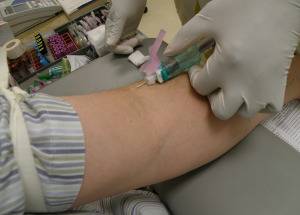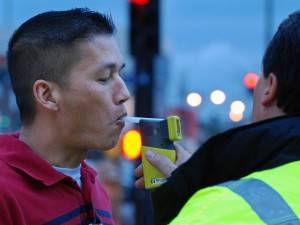Blood Alcohol Content (BAC) Tests in California
Basic BAC Test Information and Procedures
Your BAC level is defined as the percent of alcohol in your bloodstream at one time. It is measured as grams of alcohol per 100 milliliters of blood; or grams of alcohol per 210 liters of breath. Your BAC will increase with every drink you take. There are two main chemical tests for alcohol and/or other drugs: blood, and breath.
Blood

A person qualified to take a blood sample takes a draw of blood, usually from a major vein in your arm.
The person draws enough blood so that the sample may be retested. 1 The sample is taken as soon as possible after an offense . The blood is then mixed with an anticoagulant and preservative. 3
The part of the sample that remains after testing is preserved for 1 year after the date of collection.4
Breath
You must be observed for 15 continuous minutes before being given a breath test. 5 A machine operator must get two separate test results that differ by no more than 0.02 grams per 100 milliliters of blood alcohol. 6 Breath tests measure deep lung air, also known as alveolar air. This type of air provides the most accurate sample to get results. The device that you breathe into multiplies the amount of alcohol in the breath sample by 2100. This provides the operator with your blood-to-breath partition ratio. The device then uses the amount of alcohol in your breath to calculate the amount of alcohol in your blood.
PAS
You take a Preliminary Alcohol Screening (PAS) test on the side of the road with a handheld Breathalyzer device. This may occur if a police officer believes you may be drunk driving. The handheld device is not the same as the Breathalyzer machine at a police station or mobile unit at a DUI checkpoint. The Breathalyzer machine is bigger and provides more reliable results than the PAS device. You are not required to take a PAS test unless you are under 21 or on probation or parole. Therefore it is recommended that you do not take this test unless you fit into one of the above categories.
Breathalyzer
You take a Breathalyzer test in a police station or a mobile unit at a DUI checkpoint. Typically, a mouthpiece is attached to the Breathalyzer. The power button is pressed and released. The unit has to warm up until a display indicates that you should blow. You blow for about 4 seconds, as you hear a mechanical beeping noise. When the beep stops, you stop blowing. The device takes a bit to provide results about your breath sample. The test result is displayed, and an operator records the result.
Invalidating Chemical Test Results

An experienced criminal defense attorney from Wallin & Klarich can present many reasons why chemical test results can be invalidated. General reasons include: the chain of custody for your sample was broken; your sample was contaminated; a person not qualified to take the sample did so; the vial containing your sample was not properly stored; the records for your test were inaccurate because record-keeping procedures were not followed; and devices used to test your sample were not operating properly. There are also reasons to invalidate a sample that are specific to a particular type of test. If you are charged with driving under the influence, all hope should not be lost.
Blood
- Your blood was drawn incorrectly.
- The vial containing your sample did not contain adequate amounts of anticoagulant and preservative. The right amounts of these chemicals allow the sample to be sufficiently preserved for a duplicate test. The inadequate amounts of necessary chemical may have caused the blood to have fermented inside the vial, producing its own alcohol.
PAS/Breathalyzer
- The breath machine stopped the test.
- The machine was not calibrated properly.
- You were unable to blow enough air for the machine to provide a result.
- The machine was not working correctly.
- Outside influences, such as radio frequency interference (RFI) and temperature, caused the results of the machine to be inaccurate. RFI happens when an electronic device such as a cell phone is close to the breath machine. Its operations interfere with the machine’s ability to determine results.
- You have an inconsistent breathing pattern. This affected the accuracy of the machine’s result.
- You blew air directly from your mouth rather than deep lung air into the machine. Mouth air can contain residual alcohol which can cause the machine to provide inaccurate data.
- You have a medical condition such as GERD, acid reflux, or chronic heartburn. This caused the machine to provide a false, high test result.
- The operator caused the machine to malfunction. This may have been due to the operator’s lack of training.
- You are on a low-carbohydrate, high-protein diet such as the Atkins Diet. This caused the machine to produce a high test result even though you had not consumed alcohol, or had not consumed enough alcohol for your BAC to be at the amount provided in the test result.
Depending on the circumstances of the case, your attorney may choose to retest your blood sample. This may aid in your defense if the retest shows that your BAC was not the required amount at the time of collection.
FAQs about Chemical Tests
1. Which type of test should I take?

There is no one answer to this question. The only way you can decide is to know the facts about the tests.
A blood test can determine whether there were substances other than alcohol in your system. A PAS or Breathalyzer test only tests for the presence of alcohol. If you were driving under the influence of a substance other than alcohol, a breath test will not pick this up.
A blood sample can be retested. A breath sample cannot. A breath sample is immediate. It is gone in an instant: none of the breath taken is retained.
It may be to your advantage to take a blood test at the police station rather than a PAS test at the site of the arrest. If your BAC is over the legal limit, there is a chance that your BAC will be reduced by the time you reach the station.
2. Should I take more than one type of test?
No. If you take more than one type of test and were intoxicated, then two types of evidence will indicate that you were under the influence.
3. Do I get to choose what type of test to take?
Only if the officer does not offer you a choice. Otherwise, you must take the test that the officer directs you to take. The exception is the PAS test. This test is optional unless you are under 21 or on probation or parole.
4. What happens if I choose not to take a test?
You will not be allowed to ask for a hardship license, also known as a work-restriction license or restricted license. Normally, you would be able to ask for this license if you were convicted of a DUI.
If the deputy district attorney charging you writes up the chemical test refusal in the complaint, or charging instrument, you may face additional penalties. This type of situation is called a “refusal enhancement”. 7 Refusal enhancements can consist of both time in jail and a driver’s license suspension.
The refusal enhancements are:
- 1st DUI: 48 hours in jail and 1-year driver’s license suspension.
- 2nd DUI within 10 years of prior: 96 hours in jail and 2-year driver’s license suspension.
- 3rd or subsequent DUI within 10 years of prior: 3-year driver’s license suspension.
The refusal enhancements are add-ons to the regular penalties for a DUI, including probation and monetary fines.
5. What if I am on probation or parole or under 21?
If any of these are true, you are required to take a chemical test.
6. Do I have to take a test if I have not been arrested?
No, unless you are under 21 or on probation or parole.
7. If I have consumed something else with alcohol in it, like mouthwash, will a test indicate that I have a higher BAC?
It may. Your attorney can argue this as a defense.
8. What is the per se limit for alcohol?
0.08 is the limit for an adult in California. 8 For a minor, any trace of alcohol is sufficient to be charged with a DUI. When your BAC is at this level, you are presumed to be driving under the influence.
9. What if I am not advised of the consequences of my right to refuse to submit to a test?
If a law enforcement officer does not make such a statement, the court cannot cause you
to suffer a refusal enhancement penalty, such as the 1-year driver’s license suspension. You can, however, still be charged with a DUI.
Wallin & Klarich Can Help

If you or someone you love has been accused of DUI, the experienced DUI attorneys at Wallin & Klarich can help protect your innocence. At Wallin & Klarich, our attorneys have been defending persons accused of driving under the influence for over 30 years. Our attorneys will vigorously fight to get you the best available outcome in your case.
With offices in Los Angeles, Sherman Oaks, Torrance, Tustin, San Diego, Riverside, San Bernardino, Ventura, West Covina and Victorville, there is an experienced Wallin & Klarich DUI and criminal defense attorney near you no matter where you live or work.
Call us today (877) 4-NO-JAIL or (877) 466-8254 for a free phone consultation. We will get through this together.
1. [CCR (California Code of Regulations) § 1291.1(b).]↩
2. [CCR § 1219.1(a)]↩
3. [CCR § 1219.1(e)(2) ]↩
4. [CCR § 1219.1(g)]↩
5. [CCR § 1219.3]↩
6. [CCR § 1221.4(a)(1)]↩
7. [Cal. Veh. Code 13353 and 23577 ]↩
8. [Cal. Veh. Code 23152(b)]↩
